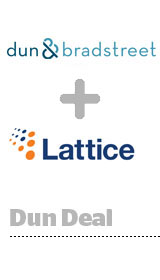
Everyone wants to capitalize on the customer data platform craze – even B2B players like Dun & Bradstreet.
The commercial database provider announced its plan Thursday to acquire Lattice Engines, a lead gen software and predictive email marketing platform for sales orgs that entered the CDP category a few years ago along with scores of other companies looking to insinuate themselves into the marketer’s stack with the promise of solving for data fragmentation.
Lattice launched its own CDP product, called Lattice Atlas, last year, which aims to help marketers automate their account-based marketing programs by centralizing segment creation and distribution.
But this acquisition gives Lattice Engines a leg up on the advancing CDP hordes, claims Michael Bird, EVP and global GM at Dun & Bradstreet. Lattice will have direct access to D&B’s entire database of third-party business-related data. Before this, Lattice was a D&B partner, and like other partners, could only get its hands on a thin slice of Dun’s data.
“A lot of companies, particularly those that do predictive analytics, ran out and became CDPs – but that market only went so far,” Bird said. “Beyond software, CDPs need to be able to match first-party data with third-party data, they need the analytics chops to do something with the data and they need the downstream integrations to execute.”
Although most CDP companies have one or even two of those pieces, they usually don’t have all three, Bird said, which is what marketers need if they’re going to “create predictive, programmatic-style lead generation that turns data into revenue.”
Dun & Bradstreet had been eyeing the CDP space ever since the company was acquired by a group of private equity firms for $5.38 billion last year and ceased trading on the New York Stock Exchange.
After going private, Dun & Bradstreet could act more nimbly, Bird said, and added new technology, like a CDP.
Although most CDPs are geared toward consumer marketers, B2B marketers are dealing with many of the same data challenges.
“B2B marketers are being tasked with revenue and lead generation, they’re swimming in data, they manage multiple mar tech stacks and they’re spending way too much time trying to segment audiences,” Bird said. “They’re struggling even though there’s no shortage of technology and data, because it just hasn’t quite all come together yet.”
With a CDP, marketers can in theory more easily model their CRM data and flow segments directly into an activation platform. Salespeople can also use the same data technology to figure out the next best action for their sales outreach.
Marketing and sales alignment is something people have talked about for a long time, Bird said, but it’s never really gotten very far, because everyone uses different systems.
But for all this talk about CRM, Dun & Bradstreet has no interest in becoming a media company or building any marketing automation technology of its own.
“Data is the connective tissue between CRM and execution, and that’s who we are,” Bird said. “We live between the front end and the downstream tools, between CRM and the automation platform, because marketers need more than just data flowing through a disconnected mar tech stack.”
Dun & Bradstreet declined to share what it’s paying for Lattice Engines or any details on the deal structure.
This post was syndicated from Ad Exchanger.


More Stories
The Spinoff’s three part podcast to analyse NZ media
Veteran Anchor Darla Montgomery to Retire from KLFY
Macca’s NZ celebrates community connections